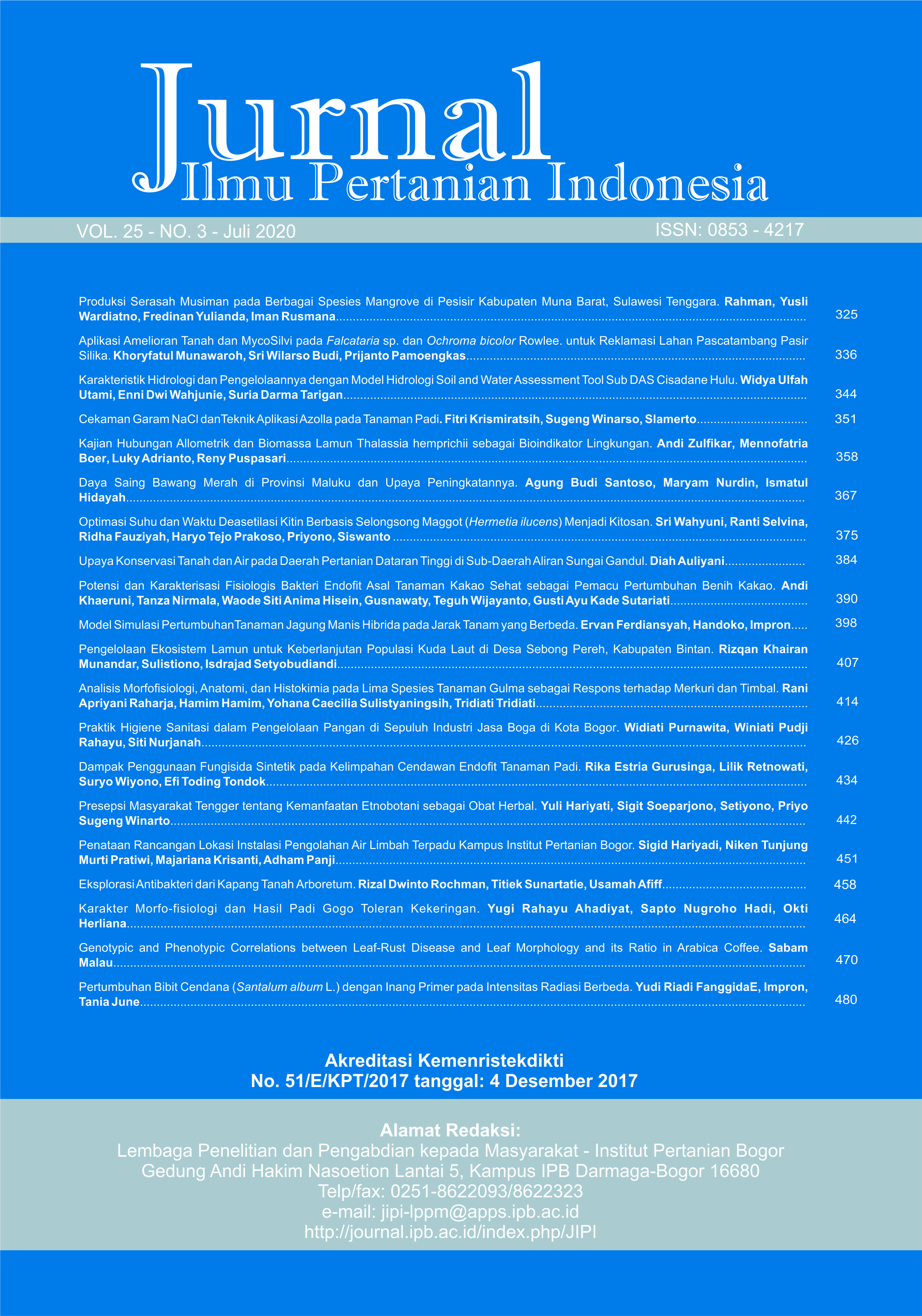Eksplorasi Antibakteri dari Kapang Tanah Arboretum
Abstract
Research to discover new antibacterial agent has been increasing due to the increasing number of pathogenic bacteria become antibiotic-resistant. Microbiomes in soil mold have antibacterial potency by producing secondary metabolites. The aim of this research was to isolate soil molds from the Faculty of Forestry Arboretum at IPB University. Arboretum’s soil was sampled ± 7.5 g from several points with maximum depth of 15 cm from surface. Mold isolate were cultivated for 28 days using waterbath shaker. Cultivated mycelium and soil filtrate were then separated and extracted using different methods and solvents, prior to antibacterial activity test using agar well diffusion method. Six isolates from Aspergillus, Penicillium, Paecilomyces, and Verticilium were used in this research. Cultivatation using sabouraud dextrose broth (SDB) contains pepton and dextrose in 25°C capable of stimulating mold growth. The research showed the result of secondary metabolit had antibacterial characteristic toward tested bacteria. The results of antibacterial activity test on both mycelium and soil filtrate extract showed that soil mold isolates had antibacterial activity against Staphylococcus aureus and Escherichia coli. Isolate 103A originated from soil filtrate formed the largest inhibition zone on both tested pathogens.
Keywords: antibacteria, mycelium, soil filtrate, soil mold
Downloads
References
Andriani CR, Oesman F, Nursanty R. 2016. Uji zona hambat ekstrak etil asetat daun alpukat (Persea americana Mill.) terhadap pertumbuhan bakteri Staphylococcus aureus. Jurnal Kedokteran Syiah Kuala. 16(1) :1–5.
Balouri M, Sadiki M, Ibnsouda SK. 2016. Methods for in vitro evaluating antimicrobial activity: a review. Journal of Pharmaceutical Analysis. 6: 71–79. https://doi.org/10.1016/j.jpha.2015.11.005
[CLSI] Clinical and Laboratory Standards Institute. 2015. Performance Standards for Antimicrobial Susceptibility Testing; Twenty–Fifth Informational Supplement. Wayne (US): Clinical and Laboratory Standards Institute.
Elias BC, Said S, Albuquerue S, Pupo MT. 2006. The influence of culture conditions of the biosynthesis of secondary metabolites by Penicilium verrucosum Dierck. Microbiological Research. 161: 273–280.
Hauser AR. 2013. Antibiotic Basic for Clinicians. Philadelphia (US): Lippincott Williams & Wilkins. https://doi.org/10.1016/j.micres.2005.10.003
Ho WH, To PC, Hyde KD. 2003. Induction of antibiotic production of freshwater fungi using mix–culture fermentation. Fungal Diversity. 12: 45–51.
Joe MM, Jayachitra J, Vijayapriya M. 2009. Antimicrobial activity of some common spices against certain human pathogens. Journal of Medicinal Plants Research. 3(11): 1134–1136.
Kasanah N, Amini, Wahyono. 1998. Karakterisasi senyawa antimikroba isolate Aspergillus sp. hasil isolasi dari tanah. Majalah Farmasi. 9(4): 166–173.
Krisnaningsih MMF, Asmara W, Wibowo MH. 2005. Uji sensitivitas Escherichia coli patogen pada ayam terhadap beberapa jenis antibiotika. Journal Sains Veteriner. 1: 13–18.
Mambang DEP, Rosidah, Suryanto D. 2014. Aktivitas antibakteri ekstrak tempe terhadap bakteri Bacillus subtilis dan Staphylococcus aureus. Jurnal Teknologi dan Industri Pangan. 25(1): 115–118.
Margiono S. 2008. Produksi metabolit sekunder (antibiotika) oleh isolat jamur endofit Indonesia. Majalah Farmasi Indonesia. 19(2): 86–94.
[NCBI] National Center for Biotechnology Information. Compound summary for CID 6344. Pubchem Compound Database [Internet]. [diunduh 30 Nov 2017]. https://pubchem.ncbi.nlm.nih.gov/ compound/ 6344.
Nursid M, Pratitis A, Chasanah E. 2010. Kultivasi kapang MFW–01–08 yang diisolasi dari ascidia Aplidium longithorax dan uji aktivitas sitotoksiknya terhadap sel kanker payudara T47D. Jurnal Pascapanen dan Bioteknologi Kelautan dan Perikanan. 5(2): 103–110. https://doi.org/10.15578 /jpbkp.v5i2.412
Russell AD, McDonnell G. 1999. Antiseptics and Disinfectants: Activity, Action, and Resistance. Clinical Microbiol Review. 12 (1): 147–149. https:// doi.org/10.1128/CMR.12.1.147
Siregar AF, Sabdono A, Pringgenies D. 2012. Potensi antibakteri ekstrak rumput laut terhadap bakteri penyakit kulit Pseudomonas aeruginosa, Staphylococcus epidermidis, dan Micrococcus luteus. Journal of Marine Research. 1(2): 152–160.
Skoog DA, West DM, Holler FJ. Crouch SR. 2004. Fundamental of Analytical Chemistry 8th Edition. Belmont (US): Brook/Cole–Thomson Learning.
Tille PM. 2013. Bailey and Scott Diagnostic Microbiology 13th Edition. Missouri (US): Elsevier.
Tscherter H, Dreyfuss. 1992. New metabolites, processes for their production and uses. Patent Cooperation Treaty PCT International Publication. 38: 28–45.
Valgas C, Souza SM, Smania EFA, Smania JA. 2007. Screening methods to determine antibacterial activity of natural products. Brazillian Journal of Microbiology. 38: 369–380. https://doi.org/10. 1590/S1517-83822007000200034
This journal is published under the terms of the Creative Commons Attribution-NonCommercial 4.0 International License. Authors who publish with this journal agree to the following terms: Authors retain copyright and grant the journal right of first publication with the work simultaneously licensed under a Creative Commons Attribution-NonCommercial 4.0 International License. Attribution — You must give appropriate credit, provide a link to the license, and indicate if changes were made. You may do so in any reasonable manner, but not in any way that suggests the licensor endorses you or your use. NonCommercial — You may not use the material for commercial purposes.






















